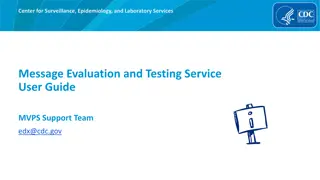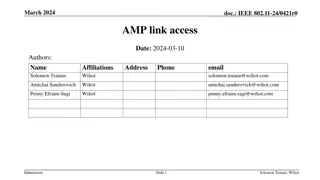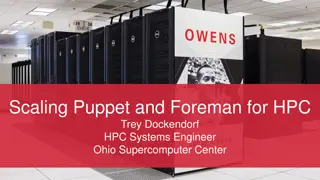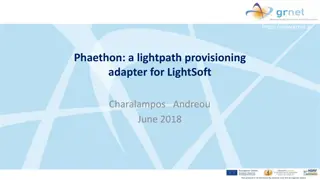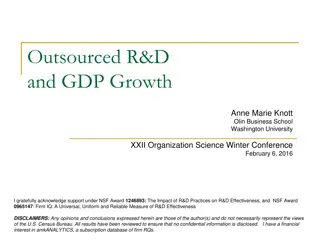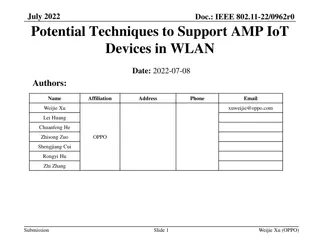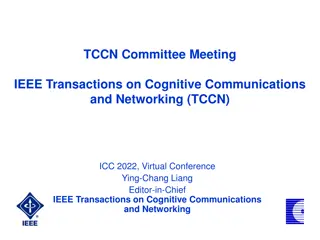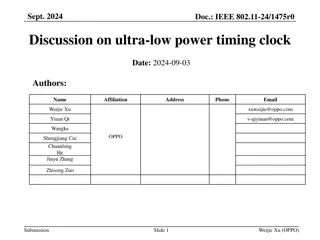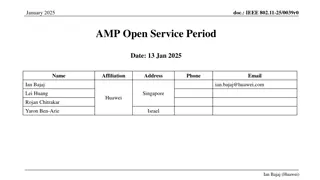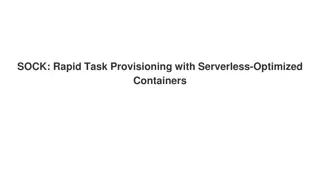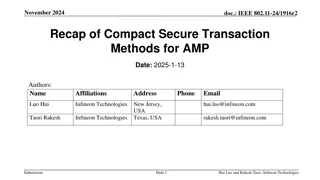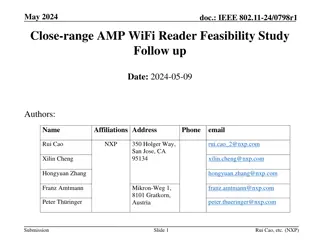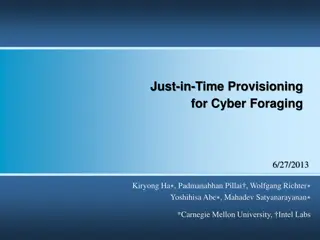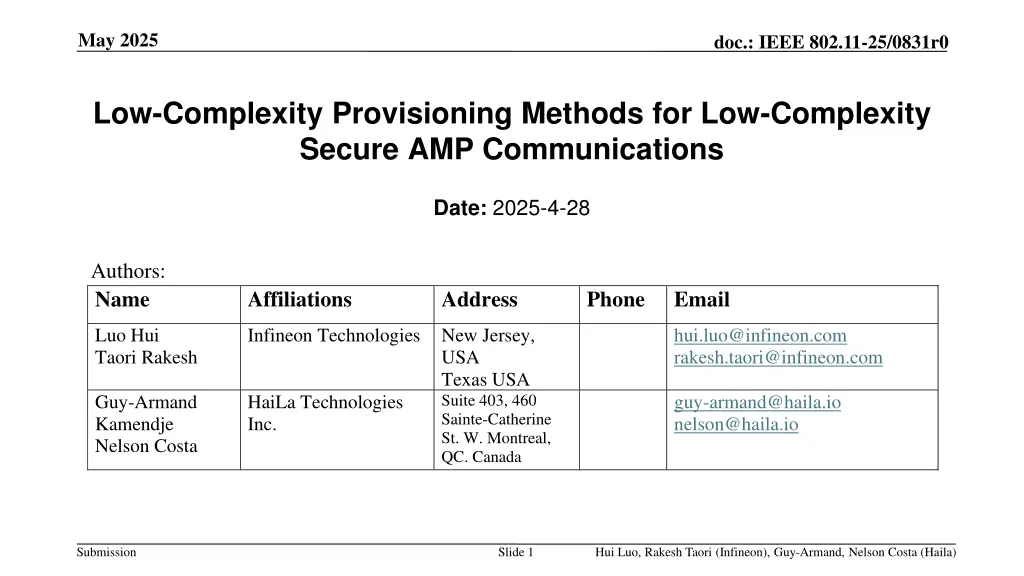
Low-Complexity Provisioning Methods for Secure AMP Communications
Explore low-complexity provisioning methods for secure AMP communications in IEEE 802.11 standards. The presentation addresses challenges, proposes solutions for high-entropy shared secrets provisioning, and discusses the use of shorter local addresses for AMP devices. Key ideas include secure data communication methods and avoiding public key algorithms in AMP devices.
Download Presentation

Please find below an Image/Link to download the presentation.
The content on the website is provided AS IS for your information and personal use only. It may not be sold, licensed, or shared on other websites without obtaining consent from the author. If you encounter any issues during the download, it is possible that the publisher has removed the file from their server.
You are allowed to download the files provided on this website for personal or commercial use, subject to the condition that they are used lawfully. All files are the property of their respective owners.
The content on the website is provided AS IS for your information and personal use only. It may not be sold, licensed, or shared on other websites without obtaining consent from the author.
E N D
Presentation Transcript
May 2025 doc.: IEEE 802.11-25/0831r0 Low-Complexity Provisioning Methods for Low-Complexity Secure AMP Communications Date: 2025-4-28 Authors: Name Affiliations Address Phone Email Luo Hui Taori Rakesh Infineon Technologies New Jersey, hui.luo@infineon.com rakesh.taori@infineon.com guy-armand@haila.io nelson@haila.io USA Texas USA Suite 403, 460 Sainte-Catherine St. W. Montreal, QC. Canada Guy-Armand Kamendje Nelson Costa HaiLa Technologies Inc. Submission Slide 1 Hui Luo, Rakesh Taori (Infineon), Guy-Armand, Nelson Costa (Haila)
May 2025 doc.: IEEE 802.11-25/0831r0 Background (1) Motion 44: IEEE 802.11bp will specify secure data communication methods that do not require maintaining security associations (note: the methods are based on existing 802.11 security protocols; the security for backscattering AMP devices are TBD; the details are TBD). SAE-based secure AMP communication methods were presented in 11-24/0178, 11-24/0526, 11- 24/0871, and 11-24/1242. These methods can support passwords (low-entropy) as authentication credentials without risking security performance, but requiring certain computation capabilities, applicable to relatively powerful AMP devices (AMP non-AP STAs) only. PMK, SNonce, ANonce, PTK-based secure AMP communication methods were presented in 11- 24/1203, 11/24-1548, 11-24/1998, and 11-24/2112. These methods have low computation complexity, applicable to all AMP devices, but requiring high-entropy shared secrets (PMK) as authentication credentials, which need to be provisioned (cannot be as simple as entering low- entropy passwords). This presentation proposes a set of low-complexity methods of provisioning high-entropy shared secrets for enabling PMK, SNonce, ANonce, PTK-based low-complexity secure AMP communications. Submission Slide 2 Hui Luo, Rakesh Taori (Infineon), Guy-Armand, Nelson Costa (Haila)
May 2025 doc.: IEEE 802.11-25/0831r0 Background (2) Some PHY/MAC details for 11bp have reached consensus, e.g., 2.4GHz DL data rates: 1Mbps (for non-backscatter STAs) and 250kbps (Motion 16) and 2.4GHz UL data rates: 4Mbps (for non- backscatter STAs), 1Mbps, 250kbps (Motion 31). Given such low data rates, it has been proposed that AMP STAs can use shorter local addresses than 48-bit 802.11 MAC addresses (11-25/0263) to reduce frame header. Question --- is it needed to provision shorter local addresses into AMP STAs? This presentation also addresses this question by proposing that the shorter addresses do not need to be fixed or provisioned. They can be generated per access attempt using a random address (for privacy and for avoiding collision if a collision is detected, the next access attempt will use a different random address). Submission Slide 3 Hui Luo, Rakesh Taori (Infineon), Guy-Armand, Nelson Costa (Haila)
May 2025 doc.: IEEE 802.11-25/0831r0 Challenges and answers for AMP provisioning AMP devices might need extra power sources or long charging time to support programming very small amount of data into non-volatile memory. It is either inconvenient or impractical to program high-entropy secrets (>=128 bits) into AMP devices. Writing 32 bits into non-volatile memory can consume 50-500uJ (11/23-1140) Harvesting 1uJ needs 1s or 0.1s at -20dbm or -10dbm (11/23-1232) Existing Wi-Fi provisioning methods heavily rely on public key algorithms. It might be desired to avoid using public key-based algorithms on AMP devices, per concerns that quantum computing will soon break RSA- based and ECC-based public key algorithms and AMP devices won t have sufficient power to run PQC public key algorithms. Key idea: store a device-specific high-entropy permanent secret P in the non-volatile memory of an AMP device during manufacturing phase. P is never changed or changed only 1 bit (1.5-15uJ) each time when the AMP device is under AMP power. P is never revealed to anyone, including the communicating AMP AP. The mission of provisioning is to ask the AMP device to generate a PMK = hash(SPA || P) for the AMP AP for low- complexity secure AMP communication between them, where SPA is the AMP AP s address (or unique ID). A set of low-complexity methods are proposed based on above ideas, without using public key algorithms. Submission Slide 4 Hui Luo, Rakesh Taori (Infineon), Guy-Armand, Nelson Costa (Haila)
May 2025 doc.: IEEE 802.11-25/0831r0 Use cases for bootstrapping provisioning Why PMK = hash(SPA||P) instead of PMK = P? Scalability. In case of PMK = P, when an AMP device needs to communicate with multiple AMP APs, the AMP device either needs to have multiple different P s or lets all AMP APs share the same P thus risking of insider eavesdropping. In case of PMK = hash(SPA || P), the AMP device only needs one P to derive multiple PMKs with different AMP AP s addresses. Supporting reprovisioning/deprovisioning by changing one bit of P. Use cases Direct bootstrapping provisioning: A user bought an AMP device and downloaded an app to his smart phone. In the first use of the AMP device, the app scans the QR code from the device s packaging material to obtain A_ID and a device-specific bootstrapping secret B, then runs a direct bootstrapping provisioning protocol, sending its address SPA to the AMP device and receiving a PMK = hash(SPA || P) from the AMP device. The app can then securely access the AMP device. The user must keep the device-specific bootstrapping information A_ID and B confidential. Manufacturer-assisted bootstrapping provisioning: A user bought an AMP device and downloaded an app to his smart phone. In the first use of the AMP device, the app scans the QR code from the device s packaging material to obtain A_ID and S_URL, then runs the manufacturer-assisted bootstrapping provisioning protocol to create a user account, register the device with the user being the owner, and receive a PMK from the manufacturer s server for secure communication between the app and the AMP device. There is no need to guard the bootstrapping information (A_ID and S_URL). There could be many enhancements, such as batch provisioning without knowing A_IDs. Shared AMP device: Two or more users are allowed to securely access the same AMP device. All users follow the above direct or manufacturer-assisted bootstrapping provisioning protocol to receive their PMKs from the AMP device or from the manufacturer. They can then securely access the AMP device with confidentiality assurance, i.e., user 1 s app cannot decrypt data exchanged between user 2 s app and the AMP device, because their PMKs are different, and cannot derive PMK1 from PMK2 or vice versa. Principle: given a high-entropy P, it is computationally impossible to derive hash(SPA1||P) from hash(SPA2||P) with SPA1 and SPA2 being known. Slide 5 Submission Hui Luo, Rakesh Taori (Infineon), Guy-Armand, Nelson Costa (Haila)
May 2025 doc.: IEEE 802.11-25/0831r0 Other use cases Reprovisioning: A deployed AMP device could be used for years. It is a good safety measurement to update the PMK once a while, and an in-band method is preferred because the deployed AMP device may not be physically accessible again. An app that is already provisioned with a PMK can run the reprovisioning protocol to get a new PMK. Because the built-in secret P is never revealed and has high entropy, no one can derive the new PMK from the old PMK. Principle: given high-entropy P and P with 1 bit difference, it is computationally impossible to derive hash(SPA||P ) from hash(SPA||P) with SPA being known. Deprovisioning: An AMP device s ownership could be transferred from one user to another user. The current user that has been provisioned with a PMK can run the deprovisioning protocol to make its PMK invalid. The new user can follow the bootstrapping provisioning protocol to get a new PMK. Again, because the built-in secret P is never revealed and has high entropy, the old user cannot derive new PMK from its old PMK. Dynamic provisioning: The owner of an AMP device A may need to provide the capability of secure access to the AMP device to a contractor s reading device R and revoke R s access rights after the contract finishes. The owner may set up a server S (probably collocated on an AP with which R is associated), and let A and S share a PMK, which is obtained and saved in S by A s owner using a bootstrapping provisioning method by supplying R s address SPA to A or the manufacturer. S manages whether R can access A based on R_ID and R_credential. R does not even know A_ID, but it knows a meaningful name of A. It can ask S using the name of A to get a one-time token hash(R1||SPA||A_ID) to access A, where R1 is a random nonce. When R is allowed to access A, R is given a PTK from S per access. After R s access right is revoked, R does not gain any confidential information about accessing A, including A_ID and PMK. Principle: given a high-entropy PMK, it is computationally impossible to derive the PMK from a PTK. Submission Slide 6 Hui Luo, Rakesh Taori (Infineon), Guy-Armand, Nelson Costa (Haila)
May 2025 doc.: IEEE 802.11-25/0831r0 Direct bootstrapping provisioning Provisioning protocol (upper right) R fetches the confidential A_ID and B using an OOB method. R broadcasts a Provisioning Request frame, containing R s address SPA, a random nonce R1, and hash(R1 || SPA || A_ID). A checks if its computed hash(R1 || SPA || ID) using its built-in ID matches the received hash(R1 || SPA || A_ID). If this is true, A sends back a Provisioning Response frame, containing R1 and PMK encrypted by a key Kb generated from hash(R1 || B). R generates Kb from hash(R1 || B), decrypts the PMK, and saves it as the PMK with A if the decrypted R1 matches R1 sent by R earlier. R can verify if the provisioning succeeds by trying to access A using the PMK (lower right). Analysis Complexity: 1 round-trip of frame exchange, then A can power off. 64B DL, 48B UL + header; 3 hashes (0.05uJ), 3 AES-128 16B blocks (including AEAD; 2.9uJ) on A. Pro: Resistant to eavesdropping, offline dictionary attack (thanks to high-entropy B), man-in-the-middle attack. Replay attack can be launched but won t make damage. Can support multiple reading devices with different shared secrets. Con: Cannot control the number of provisioned reading devices. Once a reading device is provisioned, it can always access A and cannot be deprovisioned. It could be an additional cost to have device-specific OOB information printed for each AMP device. The user must keep the bootstrapping information confidential. Submission Slide 7 Hui Luo, Rakesh Taori (Infineon), Guy-Armand, Nelson Costa (Haila)
May 2025 doc.: IEEE 802.11-25/0831r0 Direct bootstrapping provisioning enhancements If A has sufficient AMP energy to program/reprogram one bit in its non-volatile memory (OTP or reprogrammable non-volatile memory), the direct bootstrapping provisioning method can have the following enhancements. One-time provisioning A one-bit flag A_provisioned is set to 0 in A s non-volatile memory when A is manufactured. If A_provisioned = 0, A will run through bootstrapping provisioning protocol, then set A_provisioned = 1 (Risk: if R fails to receive Provision_Response from A, R can no longer provision A (A becomes useless). A cannot wait a confirmation from R then set A_provisioned = 1 for preventing R from not sending confirmation for the purpose of bypassing the one-time provisioning feature). Limited provisioning An N-bit Grey counter is set to 1 in A s reprogrammable non-volatile memory when A is manufactured (in case of OTP, a N-bit array is used). If the Grey counter is not 0, A will run through bootstrapping provisioning protocol, then increment the Grey counter by changing one bit (the risk of making A useless is much smaller than one-time provisioning). Reprovisioning and deprovisioning P (>= 128 bit) is saved in A s non-volatile memory (in case of OTP, no bit toggling, just one-directional update). If A receives a Reprovision_Request frame from R that proves R knows PMK, A will randomly select one bit of P (denoted as P ), send hash(SPA || P ) as new shared secret (denoted as PMK ), wait for R to return a Reprovision_Confirm frame that proves R knows PMK , then toggle that bit of P in non-volatile memory (A can wait for confirmation from R to prevent the risk of making A useless, because replay attack must know PMK , which is impossible before R knows PMK first). If A receives a Deprovision_Request frame from R that proves R knows PMK, A will randomly toggle one bit of P in its non-volatile memory. The one-time/limited provisioning method can be combined with the reprovisioning method, then the owner does not need to guard A_ID and B after A reaches the provisioning limit. Submission Slide 8 Hui Luo, Rakesh Taori (Infineon), Guy-Armand, Nelson Costa (Haila)
May 2025 doc.: IEEE 802.11-25/0831r0 Direct bootstrapping provisioning enhancements cont d One-time provisioning Limited provisioning Submission Slide 9 Hui Luo, Rakesh Taori (Infineon), Guy-Armand, Nelson Costa (Haila)
May 2025 doc.: IEEE 802.11-25/0831r0 Direct bootstrapping provisioning enhancements cont d Reprovisioning Deprovisioning Submission Slide 10 Hui Luo, Rakesh Taori (Infineon), Guy-Armand, Nelson Costa (Haila)
May 2025 doc.: IEEE 802.11-25/0831r0 Manufacturer-assisted provisioning method Single device provisioning (upper right) 1. R fetches A_ID and S_URL from A using an OOB method, opens a secure connection to S, then sends a Provision_Request message to S, containing owner s user ID and credential, A_ID, R s address SPA. 2. After validating the user ID and credential, S generates a random number R1, encrypts a Provision_Request(A_ID, SPA) message using a key Kb derived from hash(R1| || B), where B is a shared device-specific secret between the manufacturer and A, and sends R1 and the encrypted Provision_Request(A_ID, SPA) to R. 3. R broadcasts a Provision_Request frame with R1 and the encrypted Provision_Request (A_ID, SPA). 4. Every AMP device receiving the encrypted Provision_Request(A_ID, SPA) verifies if the encrypted frame can be decrypted by its internal B, if the decrypted A_ID matches its built-in ID, and if itself can be provisioned. Only A finds all conditions are met, A then generates a random number R2 and sends back a unicast Provision_Response frame containing A_ID and PMK = hash(SPA||P) encrypted by a key derived from hash(R1||R2||B). 5. R forwards the encrypted Provision_Response message to S. 6. S decrypts the Provision_Response message, registers A_ID as a device owned by th user ID and provisioned to SPA if A_ID has not been owned by others, and sends A_ID and PMK to R. 7. R can verify if the provisioning succeeds by trying to access A using the PMK (lower right). Batch mode provisioning (no need to obtain bootstrapping information using OOB) R does not need to fetch A_ID in Step 1. Replace B in Step 2 and Step 4 s first appearance by Ba, which is not device-specific. In Step 2 and 3, A_ID in Provision_Request is replaced by ALL. In Step 4, two UL encrypted messages are needed, the first encrypted by Kb = hash(R1 || Ba) and the second encrypted by Kbs = hash(R1 || R2 || B). Step 5, 6. 7 may need to process multiple encrypted Provision_Request messages. Submission Slide 11 Hui Luo, Rakesh Taori (Infineon), Guy-Armand, Nelson Costa (Haila)
May 2025 doc.: IEEE 802.11-25/0831r0 Direct secure access to AMP devices by provisioned AMP reading devices Secure access to single-purpose read-only AMP devices (left) Only one round-trip frame exchange, then A can power off. UL data authenticated and encrypted. 64B DL, 80B UL (assuming 16B data) + header. 3 (or 4) hashes, 5 (or 1) AES block (if MIC). 4.9uJ if authentication by AES-128 AEAD, or 2.0uJ with an extra 16B MIC. Secure access to AMP devices capable of multiple UL transfers (right) N+1 round-trip frame exchanges for N round-trip UL data and DL data, all authenticated and encrypted. Initial overhead same as previous case. Rest overhead is PN and integrity code (AEAD or MIC). Submission Slide 12 Hui Luo, Rakesh Taori (Infineon), Guy-Armand, Nelson Costa (Haila)
May 2025 doc.: IEEE 802.11-25/0831r0 Provisioned server-managed secure access to single-purpose read-only AMP devices without provisioning AMP reading devices Access protocol 1. R sends R_ID, R_credential, R s address SPA, and A s meaningful name to S over a secure R-S connection. 2. S checks if R is allowed to access A. If yes, S generates a random SNonce, computes hash(SNonce||SPA||A_ID), then sends them back to R over the secure R-S connection (SNonce is made incrementing random to assist detecting replay attacks). 3. A validates hash(SNonce||SPA||A_ID). If everything is good, A then generates a random ANonce and a random address AA, derives PMK = hash(SPA||P), then PTK = hash(SNonce||ANonce||SPA||AA||PMK), and sends back an Access_Response frame containing encrypted UL data using TK as the key and PNa as PN, along with an AEAD or MIC as the data integrity code (ANonce is made cyclically bigger than SNonce with slightly less MSB random bits to assist R to detect replay attacks). 4. R sends an Encrypted_Data frame to S over the secure R-S connection. 5. S validates SNonce, ANonce, and the Encrypted_Data frame. If everything is good, S derives PTK = hash(SNonce||ANonce||SPA||AA||PMK), decrypts UL data, and sends a Decrypted_Data frame to R. Analysis The method can work with AMP devices that do not implement the bootstrapping provisioning protocol. Whether a reading device can access an AMP device can be dynamically managed by the server, thus supporting equivalence of reprovisioning and deprovisioning. One round-trip frame exchange, then A can power off. UL data authenticated and encrypted. 64B DL, 80B UL (assuming 16B data) + header. 3 (or 4) hashes, 5 (or 1) AES block (if MIC). 4.9uJ if authentication by AES-128 AEAD, or 2.0uJ with an extra 16B MIC. Submission Slide 13 Hui Luo, Rakesh Taori (Infineon), Guy-Armand, Nelson Costa (Haila)
May 2025 doc.: IEEE 802.11-25/0831r0 Provisioned server-managed secure access to AMP devices capable of multiple UL transfers without provisioning AMP reading devices Protocol 6. First 5 steps same as previous case, then S validates SNonce, ANonce, and the Encrypted_Data frame. If everything is good, S derives PTK = hash(SNonce||ANonce||SPA||AA||PMK), decrypts UL data, and sends a Decrypted_Data frame containing the decrypted UL data to R. If the UL data indicates more data exchange, S also sends PTK to R. 7. If UL data indicates R needs to send more DL data, R initializes PNr based on SNonce and ANonce, and sends a DL_Data frame to A, containing PNr and encrypted DL data using TK as the key and PNr as the PN, along with an AEAD or MIC as the data integrity code. R then increments PNr. 8. A validates the AEAD or MIC, then decrypts DL data, carries out instructions in DL data, generates UL data as response, initializes PNa based on SNonce and ANonce, and sends an UL_Data frame to R, containing PNa and encrypted UL data using TK as the key and PNa as the PN, along with an AEAD or MIC as the data integrity code. A then increments PNa. 9. Analysis R repeats from Step 5 until no more data exchange needed. N+1 round-trip frame exchanges for N round-trip UL data and DL data, all authenticated and encrypted. Initial overhead same as previous. Rest overhead is PN and integrity code (AEAD or MIC). Submission Slide 14 Hui Luo, Rakesh Taori (Infineon), Guy-Armand, Nelson Costa (Haila)
May 2025 doc.: IEEE 802.11-25/0831r0 Summary A set of low-complexity provisioning methods are presented for enabling low-complexity secure communication (authentication, key generation, and encryption) between an AMP AP and an AMP non-AP STA by provisioning a PMK derived from hash of the AMP AP s address and the AMP non-AP STA s built-in high-entropy permanent secret into the AMP AP (or a server managing the AMP AP). STA needs to implement provisioning protocol STA capable of 1-bit non-volatile memory programming STA bootstrapping information has to be kept confidential Support reprovisioning Support deprovisioning Methods Direct bootstrapping provisioning Yes No Yes No No Direct bootstrapping provisioning/reprovisi oning/deprovisioning Yes Yes Not necessary after reaching maximum allowed provisions. Yes Yes Manufacturer-assisted provisioning Not necessary if STA does not implement 1- bit direct bootstrapping provisioning protocol Not necessary if STA does not implement 1- bit direct bootstrapping provisioning protocol No Yes if STA implements 1-bit direct bootstrapping provisioning protocol Yes if STA implements 1-bit direct bootstrapping provisioning protocol Provisioned server- managed access No No No Yes Yes The ballpark numbers of DL data size, UL data size, and energy needed by AMP non-AP STAs are provided. Submission Slide 15 Hui Luo, Rakesh Taori (Infineon), Guy-Armand, Nelson Costa (Haila)
May 2025 doc.: IEEE 802.11-25/0831r0 SP1 Do you support to specify a low-complexity authentication and key generation method based on PMK, SNonce, ANonce, and PTK for secure AMP communications, where PMK is a high-entropy shared secret between an AMP AP and an AMP non-AP STA? Reference: 11-24/1203, 11-24/1548, 11-24/1998, 11/24-2112, 11-25/0831 Submission Slide 16 Hui Luo, Rakesh Taori (Infineon), Guy-Armand, Nelson Costa (Haila)
May 2025 doc.: IEEE 802.11-25/0831r0 SP2 Do you support to specify a low-complexity authentication and key generation method based on PMK, SNonce, ANonce, PTK for secure communications between an AMP AP and an AMP non-AP STA, where the shared secret PMK is derived from hash(SPA || P) with SPA being the AMP AP s address and P being a high-entropy permanent secret built in the AMP non-AP STA? Reference: 11-25/0831 Submission Slide 17 Hui Luo, Rakesh Taori (Infineon), Guy-Armand, Nelson Costa (Haila)
May 2025 doc.: IEEE 802.11-25/0831r0 SP3 Do you support to specify low-complexity methods for provisioning a device-specific shared secret PMK = hash(SPA || P) supplied by an AMP non-AP STA into an AMP AP for secure communications between them, without the need of programming or reprogramming the AMP non-AP STA, where SPA is the AMP AP s address and P is a high-entropy permanent secret built in the AMP non-AP STA? Reference: 11-25/0831 Submission Slide 18 Hui Luo, Rakesh Taori (Infineon), Guy-Armand, Nelson Costa (Haila)
May 2025 doc.: IEEE 802.11-25/0831r0 SP4 Do you support to specify low-complexity methods that can provision, reprovision, or deprovision a device-specific shared secret PMK = hash(SPA || P) supplied by an AMP non-AP STA into an AMP AP for secure communications between them, with the need of programing or reprograming only one bit in the AMP non-AP STAs non-volatile memory, where SPA is the AMP AP s address and P is a high-entropy permanent secret built in the AMP non-AP STA? Reference: 11-25/0831 Submission Slide 19 Hui Luo, Rakesh Taori (Infineon), Guy-Armand, Nelson Costa (Haila)
May 2025 doc.: IEEE 802.11-25/0831r0 SP5 Do you support to specify low-complexity methods that can provision, reprovision, or deprovision device-specific a shared secret PMK = hash(SPA || P) into a server and let the server manage secure AMP communications between an AMP AP and an AMP non- AP STA, where SPA is the AMP AP s address and P is a high-entropy permanent secret built in the AMP non-AP STA? Reference: 11-25/0831 Submission Slide 20 Hui Luo, Rakesh Taori (Infineon), Guy-Armand, Nelson Costa (Haila)
May 2025 doc.: IEEE 802.11-25/0831r0 SP6 Do you support to use random shorter local addresses for AMP non-AP STAs in secure AMP communications? Reference: 11-25/0263, 11-25/0831 Submission Slide 21 Hui Luo, Rakesh Taori (Infineon), Guy-Armand, Nelson Costa (Haila)
May 2025 doc.: IEEE 802.11-25/0831r0 Reference 1. Amichai Sanderovich, Sagi Kupferman, Yuval Amran, Considerations for AMP Devices , doc: IEEE 802.11-23/1140r0, July 10, 2023. 2. Joerg Robert, Clemens Korn, Power Consumption Calculation , doc: IEEE 802.11-23/1232r0, July 11, 2023. 3. Hui Luo, Rakesh Taori, Security Considerations in Ambient Power Communications , doc: IEEE 802.11-24/0178r0, Jan 15, 2024. 4. Hui Luo, Rakesh Taori, Server-Managed Secure Transaction with AMP Devices , doc: IEEE 802.11-24/0526r0, March 8, 2024. 5. Hui Luo, Rakesh Taori, AMP Device Initiated Secure Transaction , doc: IEEE 802.11-24/0871r0, May 10, 2024. 6. Hui Luo, Rakesh Taori, AMP Secure Transaction Methods using Random MAC address for privacy , doc: IEEE 802.11-24/1242r0, July 12, 2024. 7. Chuangfeng He, Authentication and Security transaction for AMP , doc: IEEE 802.11-24/1203r0, July 12, 2024. 8. Rojan Chitrakar, Thoughts on security for AMP , doc: IEEE 802.11-24/1548r2, Nov. 11, 2024. 9. Hui Luo, Rakesh Taori, Secure transaction methods with low computation complexity for AMP , doc: IEEE 802.11-24/1998r1, Jan 7, 2025. 10. Sanket Kalamkar, George Cherian, Alfred Asterjadhi, Secure E2E Operation for AMP , doc: IEEE 802.11-24/2112r0, Dec. 16, 2024. 11. Guy-Armand Kamendje, Vytas Kezys, Kamran Nishat, Patricia Bower, Nelson Costa, Provisioning Protocol for Long-Range AMP IoT Devices , doc: IEEE 802.11-25/0263r0, Feb 26, 2025. 12. Luke E. Kane, Jiaming James Chen, Rebecca Thomas, Vicky Liu, Matthew McKague, Security and Performance in IoT: A Balancing Act , IEEE Access, vol. 8, pp. 121969-121986, July 6, 2020. 13. Levent Ertaul, Anup Mudan, Nausheen Sarfaraz, Performance Comparison of AES-CCM and AES-GCM Authenticated Encryption Methods , 2018, https://mcs.csueastbay.edu/~lertaul/AESCCMCAMREADY.pdf 14. Bekbolat Medetov, Tansaule Serikov, Aray Tolegenova, Zhexebay Dauren, Comparative Analysis of the Performance of Generating Cryptograhic Ciphers on CPU and FPGA, 2022, https://www.jatit.org/volumes/Vol100No15/24Vol100No15.pdf 15. B. Kieu-Do-Nguyen, T. -T. Hoang, C. -K. Pham and C. Pham-Quoc, "A Power-efficient Implementation of SHA-256 Hash Function for Embedded Applications," 2021 International Conference on Advanced Technologies for Communications (ATC), Ho Chi Minh City, Vietnam, 2021, pp. 39-44, doi: 10.1109/ATC52653.2021.9598264. (0.018uJ per 32B by SHA256) 16. Mark D. Aagaard, Nusa Zidaric, ASIC Benchmarking of Round 2 Candidates in the NIST Lightweight Cryptography Standardization Process , 2021, https://eprint.iacr.org/2021/049.pdf (AES128: 12 bits per cycle; 0.28uJ/0.98uJ per 16B block by ASCON/AES128) Slide 22 Submission Hui Luo, Rakesh Taori (Infineon), Guy-Armand, Nelson Costa (Haila)


